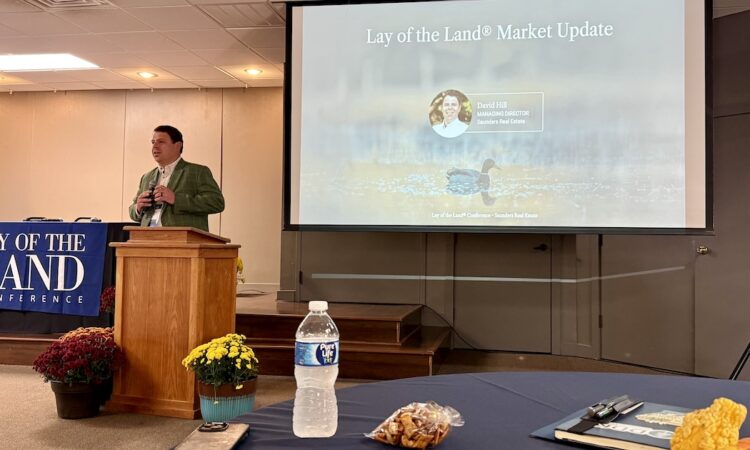
Saunders Land, the land brokerage services division of Lakeland, Fla.-based Saunders Real Estate, hosted the conference that also included presentations by other leaders from Saunders Real Estate and the University of Arkansas on topics such as the state of the agriculture sector and tax provisions in the One Big Beautiful Bill.
“The land market in Arkansas is really strong,” Hill said. “It is still a great asset. Despite a lot of the challenges that our landowners are facing, it’s a great investment, especially here in the state, especially here in Northwest Arkansas as well. If folks keep moving here, which they are, then I’m optimistic about where we’re headed.”
The inaugural Lay of the Land Arkansas Market Report tracked 998 transactions comprising land sales exceeding 50 acres. Of those transactions, 882 were arm’s length or in which the seller and buyer are unrelated. The report broke down transactions by region and land use.
North Arkansas, which includes Northwest Arkansas, had the most transactions for hunting and recreation land. It had 123 of the 223 total sales in Arkansas. In the region, 16,200 acres were sold for $57.66 million. Central Arkansas had the highest per-acre price at $9,046. In the region’s 25 transactions, 2,626 acres were sold for $19.44 million.
“No secret, but there’s still and probably always will be a very strong demand for quality waterfowl properties, given our reputation as the duck hunting capital of the world,” Hill said.
2025 DEALS
He also discussed land transactions across the state through a portion of 2025. So far this year, North Arkansas has had the most transactions in hunting and recreation land. This includes 5,500 acres sold, with an average price of about $4,000 per acre. The statewide average is about $3,500 per acre.
For timberland, the majority of the transactions are in southern Arkansas, with the top three in Perry, Calhoun and Ouachita counties. Those transactions ranged from $9.08 million to $9.44 million and between 1,387 and 4,233 acres of timberland. The highest value transaction was for 1,387 acres in Perry County, while the third-highest was for 4,233 acres in Ouachita County.
So far this year, North Arkansas timberland transactions are averaging about $4,800 per acre. It’s $2,370 an acre in Central Arkansas and $2,400 in South Arkansas.
In 2024, the largest three transactions for row crop farmland were in the Delta: $35.22 million for 2,946 acres in Arkansas County, $11.77 million for 1,038 acres in Cross County, and $9.26 million for 1,360 acres in Jackson County. So far this year, 7,200 acres of farmland have been sold in 23 transactions at an average price of $7,263 per acre.
Hill said this is “right on track for what we’ve been seeing year-over-year there.”
For pastureland, a total of $34.5 million in transactions has taken place so far in 2025. The transactions include 4,500 acres at an average price of about $7,500 per acre. He noted the majority of the transactions are in Northwest Arkansas, comprising Benton, Madison and Washington counties.
Hill also discussed transactions in Northwest Arkansas. He said transitional land transactions are primarily taking place in Northwest Arkansas. This is when agricultural land, comprising pasture or timberland, transitions “into development land with the pressure going on from just the growth that we’re experiencing in this part of the state.”
In 2024, the top three transactions for transitional land were in Benton and Madison counties, including $15.49 million for 2,700 acres in Benton County, $6.34 million for 249 acres in Madison County and $6 million for 199 acres in Benton County. Prices often range from $35,000 to $70,000 per acre for transitional residential land, the report shows.
So far this year, more than 700 acres have sold in Northwest Arkansas, Hill said. The average price per acre is more than $69,000.
“If all signs that have been pointing toward the growth over the next 25 years continue to come true, I don’t think that that per-acre price is going to come down anytime soon,” he said. “The demand for land in at least Northwest Arkansas has not slowed, but it has to be priced right. If it’s not, it does tend to sit there more than we’ve seen kind of coming out of COVID … If we can get some lower interest rates, hopefully some folks that have been on the sidelines can reenter the market, start buying some deals.”
TAX PROVISIONS
Tyler Davis, president of Saunders Real Estate, discussed the tax provisions impacting landowners, land investors and real estate owners.
He said some of the tax provisions from the 2017 federal tax law, the Tax Cuts and Jobs Act, were extended or made permanent in the One Big Beautiful Bill that became law when President Donald Trump signed it on July 4. He said the estate and gift tax exemption has been set at $15 million per person. The exemption was made permanent and “indexed for inflation in the future.” A person can give up to $19,000 to someone or $38,000 to a couple each year without facing a tax.
The new law also made permanent 100% bonus depreciation, allowing businesses to deduct the cost of qualifying assets in the year they are put into service. This applies to qualified property acquired and placed into service after Jan. 19.
“So if you bought a property, closed on the 18th, and put it into service on the 18th, tough luck,” Davis said.
The qualified business income 20% deduction was also made permanent, allowing eligible taxpayers to deduct up to 20% of their qualified business income, plus 20% of qualified real estate investment trust dividends.
Some of the changes to the Opportunity Zone program put a greater emphasis on rural areas, “which can impact your landholdings, your land investments, (and) your infrastructure investments on those … So, 38% of all the opportunity zones are now rural in nature.” The new law reduces the requirement to improve a property in a rural opportunity zone from 100% to 50% of the initial investment. Investors can defer taxes on capital gains that are invested into an opportunity zone. If an investor holds the investment for at least 10 years, any capital gains on the new investment are excluded from taxes when sold.
“If you’re looking at buying an operation, buying farm land that needs a lot of substantial improvements to it, this is a good program worth looking at,” Davis said.
A new program in the law is the qualified production property deduction, he said. This was created “as an effort to incentivize people to start bringing more manufacturing here … It allows the immediate expensing of any manufacturing, production, refining facility that you would build … or that you’d buy. This also applies to agricultural production, which is really important … The ability to fully write off an investment project, a development project in year one, this has never been in place before. A lot of savvy developers, industrial developers around the country are maximizing this. And you’re going to start seeing more and more big box warehouses, manufacturing facilities coming out of the ground because people are taking advantage of this.”
Davis said the farm sale tax payment plan allows sellers to defer capital gains tax into four equal annual payments. This applies to agricultural property that’s sold and remains agricultural property.
He provided an example of using the interest on the capital gain that’s put into a bond to pay the tax. Someone sells their farm for $1 million and has a gain of $400,000. This can be used to buy a bond that pays 5% for four years.
“That’s $20,000 in interest every year,” Davis said. “That’s your tax payment, right?”
ECONOMIC UPDATE
Dr. Bruce Ahrendsen, professor of agricultural economics and agribusiness at the UA, said the ag sector is “A Tale of Two Cities.” Cow-calf operators are experiencing good times, while crop farmers are facing some of the worst times.
In Arkansas, crop receipts are projected to fall for corn and cotton from 2024 to 2025 and for rice continuing into 2026, Ahrendsen said. Soybean receipts will remain flat. He said crop expenses have risen, and livestock farmers are seeing lower feed costs.
Ahrendsen said the delinquency rates on commercial bank loans are “really high” but “not out of this world, never seen before yet numbers. Hopefully they don’t get to that point.”
Farm loan repayment rates are down, and farm household spending is falling “because they don’t have as much to be able to spend,” he said. Also, more farmers are filing for Chapter 12 bankruptcy protection, which helps farmers restructure debt while continuing to operate.






